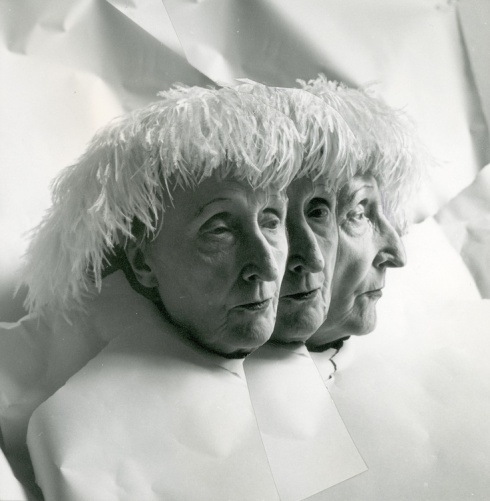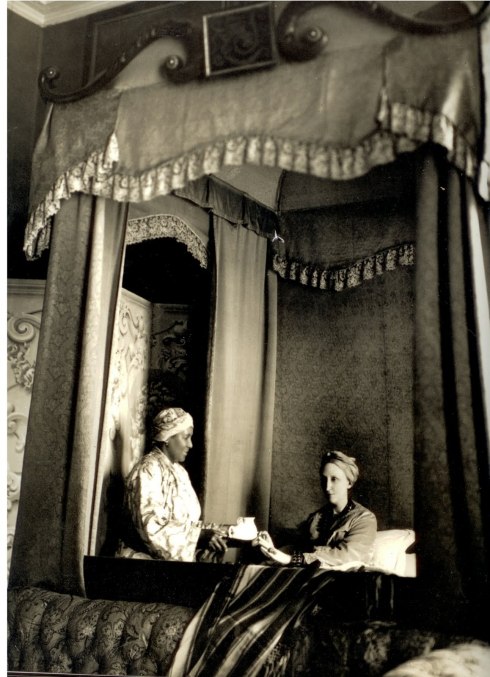 Edith Sitwell multiple exposure, Cecil Beaton, 1962
Edith Sitwell multiple exposure, Cecil Beaton, 1962
.
“The two greatest mannequins of the century were Gertrude Stein and Edith Sitwell – unquestionably. You just couldn’t take a bad picture of those two old girls”
A quote by Diana Vreeland
Short Biography
Edith Sitwell (1887 – 1964) was born in a very wealthy, aristocratic family. She got two younger brothers (also authors), Osbert and Sacheverell, who, like Edith, had a hard time growing up with their eccentric, unloving parents.
When still a teenager, Edith’s father made her undertake a “cure” for her supposed spinal deformation, involving locking her into an iron frame.
 Edith, Sacheverell and Osbert Sitwell, 1930’s
.
Edith, Sacheverell and Osbert Sitwell, 1930’s
.
At 23, she began publishing poetry and three years later she moved to a shabby flat in London, which she shared with her governess, Helen Rootham. In 1932 together they moved to Paris to live with Helen’s younger sister. Helen Rootham died six years later of spinal cancer. This was a tragedy for Edith, for she had never lived alone before.
Although she spent her life unmarried, Edith was passionately in love with the homosexual Russian painter Pavel Tchelitchew. This love was Edith’s most important, yet most unfulfilling, relationship of her long life. For her the spark was definitely there and it did not matter that she was almost eleven years Pavlik’s senior, initially the relationship was one of great intimacy.
In the beginning, Pavlik was captivated by Edith’s extraordinary presence and later painted her portrait several times. Sadly, he only offered “Sitvouka” friendship and with no other choice, Edith accepted. Pavel’s interest in her seemed purely intellectual and quite possibly financial, the thought of Edith laying her hands on him in an intimate way appalled him.
 Pavel Tchelitchew by Cecil Beaton, 1930s
Pavel Tchelitchew by Cecil Beaton, 1930s
 Edith In front of a Pavel Tchelitchew Portrait of her
.
Edith In front of a Pavel Tchelitchew Portrait of her
.
Pavel started to design her clothes and her signature look was born. Edith always tried to be somewhere near Pavel, who once said to her: “Nobody has ever understood you better, or come closer to you than I have and nobody ever will!”
Edith went to New York after the war, where the friendship almost ended as the result of a wild scene that Pavel made in a New York restaurant. Apparently, “white-faced with anger,” he denounced Edith for being “self-obsessed” and for letting herself be corrupted by the “vulgar social figures that surrounded her.” Pavel further accused her of betraying the poet in her, the part he cherished, and “crudest of all, he coldly told her that everything that had ever been between them now was over.”
 Pavel Tchelitchew, Edith Sitwell and Pavel’s partner Allen Tanner
.
Pavel Tchelitchew, Edith Sitwell and Pavel’s partner Allen Tanner
.
Crushed, Edith sailed for home the next day and spent the entire Atlantic crossing in bed.
Although, it was possible for her to eventually forgive him the friendship barely survived. It was a disaster of failed nerves and disappointed expectations on the sides of both.
During the WWII Edith had retired to Renishaw with her brother Osbert and his lover David Horner. She wrote under the light of oil lamps as the house had no electricity. She was lucky that during her lifetime she was surrounded by people who appreciated her and her two brothers as central to the artistic life of the times.
 Edith Sitwell by Jane Brown, 1959
.
Edith Sitwell by Jane Brown, 1959
.
Edith Sitwell provoked many critics in conservative Great Britain because of her dramatic work, but also because of her unusual appearance. She resembled Queen Elizabeth I (they also shared the same birthday) dressed in exotic costumes, brocade and velvet gowns, adorned with gold turbans and huge colourful rings that reflected what she claimed: ‘good taste is the worst vice ever invented.’
She was created Dame of the British Empire in 1954. Three years later Edith got ill and ended up in a wheelchair. She passed away in 1964.
.
“I am not eccentric. It is just that I am more alive than most people are. I am an unpopular electric eel set in a pond of goldfish”.
(Edith Sitwell, quoted in Life magazine, 4 January 1963) Edith Sitwell, 1962
Edith Sitwell, 1962
.
.
Edith Sitwell (and brothers) by Cecil Beaton
 1927
1927
 1928
1928
 Edith Sitwell and her brothers, 1930s
Edith Sitwell and her brothers, 1930s
 1930s
1930s

 1927
1927
 Vanity Fair. Edith Sitwell and her brothers by Cecil Beaton, 1929
Vanity Fair. Edith Sitwell and her brothers by Cecil Beaton, 1929
 1930s
1930s
 1962, the photographs taken for her 75th birthday
1962, the photographs taken for her 75th birthday
 1962, the photographs taken for her 75th birthday
1962, the photographs taken for her 75th birthday
 1962, the photographs taken for her 75th birthday
1962, the photographs taken for her 75th birthday
 1962, the photographs taken for her 75th birthday
1962, the photographs taken for her 75th birthday
 1962, the photographs taken for her 75th birthday
.
1962, the photographs taken for her 75th birthday
.
Edith Sitwell first met Cecil Beaton on 7 December 1926 at the home of Allannah Hooper. It was a fateful meeting because the photographs that Beaton made of Sitwell later in 1926, then in 1927 and 1931, brought them both much fame.
The portraits that he took in 1926 and 1927 were all prefabricated set-ups prepared in dimly lit interiors.
In 1962, wearing her black ostrich feather turban faced with sheer organza, she welcomed Beaton into her apartment at Greenhill in Hampstead. She had commissioned portraits from him to mark her 75th birthday. She knew that they would be published internationally and would create an instant sensation. They did and you can see why. She is performing her eccentric fame for the camera and is much more beautiful at 75 than she was at 25.
Her style was an essential part of her character. But she had also had teasing sense of humour. Early on, Cecil Beaton noted ‘the twinkle in her eye’.
.
The trouble with most Englishwomen is that they will dress as if they had been a mouse in a previous incarnation, they do not want to attract attention.
Edith Sitwell.
Edith Sitwell by Horst P. Horst
 Horst photographed Edith in 1948 for Vogue in New York. Here-along with her aquamarines-Edith wears two massive brooches. Horst says “Edith Sitwell wore extravagant clothes and Jewels; usually the clothes did not fit at all they just hung. She did it exactly her own way and got away with it.” “She was considered an Improbable and anachronistic fashion icon frequently photographed bristling with gigantic aquamarine rings– at least two to a finger, and plastered with vast brooches of semi-precious stones”
Horst photographed Edith in 1948 for Vogue in New York. Here-along with her aquamarines-Edith wears two massive brooches. Horst says “Edith Sitwell wore extravagant clothes and Jewels; usually the clothes did not fit at all they just hung. She did it exactly her own way and got away with it.” “She was considered an Improbable and anachronistic fashion icon frequently photographed bristling with gigantic aquamarine rings– at least two to a finger, and plastered with vast brooches of semi-precious stones”
The ‘Aztec’ necklace
 ‘This gold collar was made for me by an American woman called Millicent Rogers. She was one of my greatest friends, though I only met her once. She sent it to me and the British Museum kept it four days and thought it was pre-Columban, undoubtedly from the tomb of an Inca-though they couldn’t make out how the gold could be stiffened in a way that wasn’t in existence in those days. But I have to be careful of the clanking when I am reciting and don’t often wear it for that.’
‘This gold collar was made for me by an American woman called Millicent Rogers. She was one of my greatest friends, though I only met her once. She sent it to me and the British Museum kept it four days and thought it was pre-Columban, undoubtedly from the tomb of an Inca-though they couldn’t make out how the gold could be stiffened in a way that wasn’t in existence in those days. But I have to be careful of the clanking when I am reciting and don’t often wear it for that.’
The rings
 Ph. Philippe Halsman, 1937
.
Ph. Philippe Halsman, 1937
.
‘I feel undressed without my rings. These aquamarines I love, but I’ve got a beautiful topaz like a sunflower–and when I’ve worn these too much I feel it’s being neglected….I’ve got red and green and black amber bracelets, and a ring I call tiger into grape. Its yellow, veined with blue and red, but when it snows it turns blue.’
.
.
Edith Sitwell & Marilyn Monroe
 Edith Sitwell & Marilyn Monroe
Edith Sitwell & Marilyn Monroe
People were expecting the two women to dislike each other. Instead of giving the waiting photographers a good scandal, Edith and Marilyn hit it off immediately. Edith described Marilyn in her autobiographyTaken Care Of:
In repose her face was at moments strangely, prophetically tragic, like the face of a beautiful ghost – a little spring-ghost, an innocent fertility daemon, the vegetation spirit that was Ophelia.
Marilyn was an autodidact but her intellectual curiosity and love of books were not considered consistent with her sex symbol image. Marilyn and Edith sat together chatting happily about Austrian philosopher, esoteric spiritual writer, and founder of anthroposophy Rudolf Steiner, whose books Marilyn had recently been reading.
 Pavel Tchelitchew Portrait of Edith Sitwell
Pavel Tchelitchew Portrait of Edith Sitwell
info:
wikipedia
http://theesotericcuriosa.blogspot.nl/2010/02/unrequited-love-broken-heart-edith.html
http://aucklandartgallery.blogspot.nl/2010/08/1962-portraits-of-dame-edith-sitwell-by.html





Very interesting history of this amazing woman!
Informative, educational, most entertaining. Bravo !.